Visualising the Great Pacific Garbage Patch
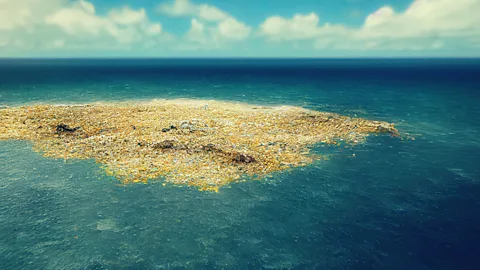 Shutterstock
ShutterstockIn 1997 Captain Charles Moore was sailing from Hawaii to California when he noticed a steady stream of plastics bobbing in the ocean. He had discovered the Great Pacific Garbage Patch.

Over a thousand miles from land in the central North Pacific Ocean, the boat captain and oceanographer Captain Charles Moore puzzled over the source of the litter.
"It can't be a trail of breadcrumbs like Hansel and Gretel leading me home," he recalled thinking. "This has got to be a larger phenomenon."
After two years of research and modelling, he returned to investigate. "That's when we had the aha moment," he says. Using a net system to sample the surface of the ocean, he found six times as much plastic as plankton floating in the ocean.
Moore had discovered the largest of five garbage patches around the world. Created by swirling ocean currents known as gyres, these act like a trash vortex, sucking in plastics and shifting constantly.
Since its discovery, the Great Pacific Garbage Patch (GPGP) has often been depicted in the media as a floating mass of plastic, and referred to as a trash island. However, contrary to popular belief, there is no surface on which to stand and it can't be seen from space.
"It wasn't a mountain of trash, or a field of trash, it wasn't even a patch of trash," says Moore. Instead, the ocean looked like a murky soup, made up of different sized plastics.
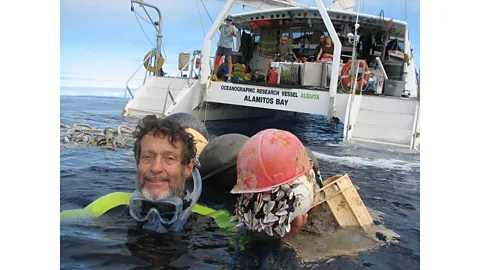 Algalita Marine Research and Education
Algalita Marine Research and EducationThis makes visualising the patch difficult. "There is no such thing as a photo of the Great Pacific Garbage Patch," says Moore. Satellites, drones and Google Earth struggle to capture an overview of the highly mobile garbage patch, he says.
In the following 25 years, our understanding of garbage patches has deepened, with some attempting to quantify and clean them up. But many misconceptions still exist about these remote garbage patches, where few people can venture themselves.
Sign up to Future Earth
Sign up to the Future Earth newsletter to get essential climate news and hopeful developments in your inbox every Tuesday from Carl Nasman. This email is currently available to non-UK readers. In the UK? Sign up for newsletters here.
The scale of the GPGP is so great, it is often imagined as a landmass. A 2018 study predicted at least 79,000 tonnes of ocean plastic are floating inside an area of 1.6 million sq km (618,000 sq miles) – a figure that is four to 16 times higher than previously reported. This is twice the size of Texas, or three times the size of France.
In 2017, an advertising stunt for World Oceans Day contributed to this perception, by calling on the United Nations to rename the GPGP Trash Isles. The campaign rallied to make the area the world's 196th country, fit with its own flag, passports and currency.
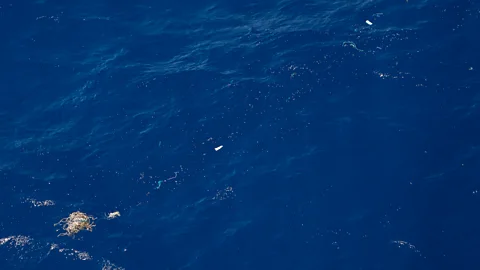 The Ocean Cleanup
The Ocean CleanupAlthough this raised the profile of the world's plastic problem, it played into myths surrounding the GPGP. A Google Image search still incorrectly reveals pictures of the GPGP as a solid mass of plastics, in some cases appearing almost sturdy enough to walk across.
In reality, ships can sail in and out, and mariners may not even release they are passing through a garbage patch. Studies indicate that – while more than 75% of the total mass of the garbage found in the GPGP is of debris greater than 5cm (1.9 in) in size – microplastics account for 94% of the estimated 1.8 trillion pieces floating in the area.
Common misconceptions can dampen the urgency to treat garbage patches. "The problem is that most people are not aware of the issue, therefore they don't feel motivated enough to be engaged in solutions," says Walter Leal, a professor of Environment and Technology at Manchester Metropolitan University in the UK.
Left unchecked, more trash will accumulate in garbage patches. "Indeed, they are growing bigger as we speak," says Leal. One 2021 paper predicts that the growth rate is 2.5% based on current trends – but the authors of the report warn that is a conservative estimate.
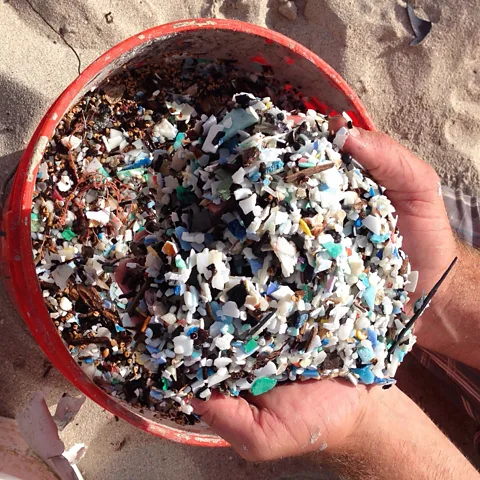 NOAA
NOAAOcean plastic can generate a host of environmental hazards, from the entanglement of creatures such as turtles, to consumption by birds and fish as it is mistaken for food.
The problem is so widespread it has given rise to the "plastisphere" – a term used for ecosystems that have evolved to live in human-made plastic environments.
In a recent study, researchers identified 484 invertebrates from around 100 pieces of plastic fished from the GPGP. Ocean currents had transported some species away from their natural habitat to live on plastics in the patch, risking strange mutations or biohazards.
Garbage patches accumulate in the high seas – the parts of the ocean that are beyond territorial waters – so few governments will take responsibility for them. However, the problem is becoming harder to ignore, says Leal.
Carbon Count
The emissions from travel it took to report this story were 0kg CO2. The digital emissions from this story are an estimated 1.2g to 3.6g CO2 per page view. Find out more about how we calculated this figure here.
On a recent trip to the South Pacific Leal recalls seeing plastic wash up on the shores of island nations such as Fiji, The Cook Islands and Vanuatu. "These countries produce no plastic, but some plastics from the gyres find the way to the coast. That will also have an impact on tourism," he adds.
In the absence of government action, others have made it their mission to clear up garbage patches. One of the most famous attempts is by The Ocean Cleanup, a non-profit organisation founded by Dutch entrepreneur Boyan Slat.
At the age of 16, a high-school research paper on the GPGP coincided with a personal awakening about marine litter. "I went scuba diving in Greece and I saw more plastic bags than fish," says Slat.
He scribbled a drawing on a paper napkin, which became the foundation of his tech-powered plan to clear the GPGP. Since then, The Ocean Cleanup has raked in millions of dollars of investment from donors such as the band Coldplay and The Coca-Cola Company.
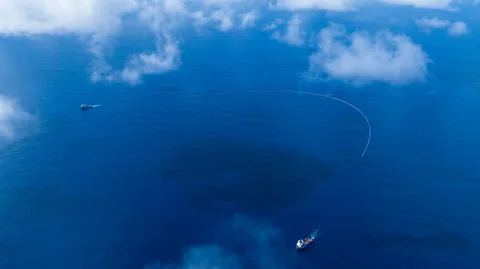 The Ocean Cleanup
The Ocean Cleanup"The solution is 50% hardware and 50% software," Slat says. System 03 – the latest iteration – uses computer modelling to map high-density plastic hotspots and steer the removal technology.
A long u-shaped, net-like barrier "five school buses in length" is dragged through patches of rubbish by two boats.
The goal is to scale up and clean 90% of the patch's plastic by 2040 – although some experts have questioned the plan's feasibility, stating that using boats to transport plastic from ocean garbage patches to ports could have a high carbon cost.
"It's crazy to think if we didn't pull this stuff out it would be out there killing sea life. Imagine if we were doing this in reverse, how much outrage that would spark across the world," says Slat.
You might also like:
Whether technology is the answer or not, experts are in agreement that reducing plastic production will be a key driver in limiting garbage patches.
One "silver lining," says Leal, is an international plastics treaty, which will be negotiated in 2024.
The treaty will see 175 nations develop a legally binding agreement on plastic pollution to prevent new plastics ending up in the ocean and reaching garbage patches.
But for Captain Moore, agreeing to stymy plastic at the source has been a long time coming. "Plastic production is going up and that's the opposite of a solution," he says. "The solutions will involve reducing the amount of plastic produced."
--
If you liked this story, sign up for The Essential List newsletter – a handpicked selection of features, videos and can't-miss news delivered to your inbox every Friday.
